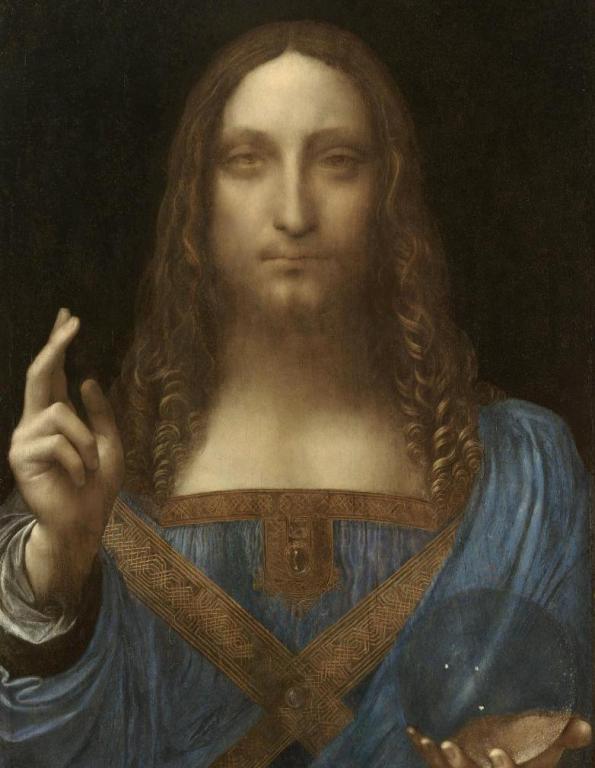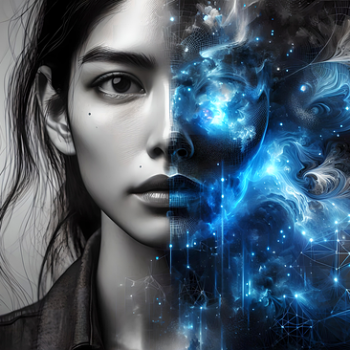Leonardo da Vinci was not only a great artist. He was also a great scientist–and engineer, mathematician, inventor, and much more. For Leonardo, these were interconnected, not separate specialities, reflecting the integration of knowledge that is the goal of classical learning. The new painting of his that was recently discovered, “Savior of the World,” which we discussed recently, demonstrates how Leonardo integrated his scientific research with his art.
Da Vinci biographer Walter Isaacson focuses on some striking details of the painting in his article Why ‘Salvator Mundi,’ which sold for $450 million, is further proof of Leonardo da Vinci’s genius in The Washington Post. Notice how the “science” is not just added onto the art, but that Leonardo’s study of nature is responsible for the painting’s most evocative aesthetic effects. Isaacson writes,
Leonardo’s feel for the patterns and connections of nature helped him to create, in “Salvator Mundi,” a face that manages to be at once both reassuring and unsettling. Jesus’ stare follows us as we move, and it seems to interact with us. Is he staring at us or into the distance? Move from side to side and ask again. Is there a hint of a smile? Look again. Is his blessing hand moving out at us?
Leonardo worked out the mathematics of perspective, how objects appear smaller the farther away they are, a phenomenon that he and other Renaissance artists exploited to create the illusion of three-dimensional depth on a flat surface. But Leonardo’s study of optics, Isaacson explains, included “acuity,” how the eye focuses. Objects farther away appear blurrier, whereas closer objects are in sharper focus.
“You must diminish the sharpness of those objects in proportion to their increasing distance from the eye of the spectator,” wrote Leonardo. “The parts that are near in the foreground should be finished in a bold determined manner; but those in the distance must be unfinished, and confused in their outlines.”
Thus, in this painting Christ’s hand of blessing is sharply drawn, compared to the rest of the painting, making it appear as if Christ’s hand is reaching towards us.
Leonardo also worked with the way light plays on the surface of the retina and on what it means for our perception that we have two eyes. Isaacson says,
From his optics studies he knew that light does not register in a single point in the eye but instead is perceived along the entire retina. Combined with the fact that we have two eyes, this means that we perceive the edges of objects as slightly blurred rather than sharply delineated. This led to his mastery of sfumato, the gentle blurring of lines in his paintings. We see that technique in blurred outlines of Jesus’ face.
I would add that this is why Jesus’s eyes appear to follow us no matter what angle we look at them. In the comments in our earlier discussion, it was noted that the eyes are not quite in line, which is part of this illusion
Leonardo not only pioneered the study of optics, he studied anatomy, dissecting cadavers in the morgue to understand the muscles and structures of the human body. Isaacson discusses how Leonardo explored the physiology of the smile. Some muscles of the lips turn up, while others turn down.
Leonardo’s portraits are notable for their subtle, evocative smiles. We see this, most famously, in Mona Lisa, but also St. John the Baptist, and now Savior of the World (Salvator Mundi). Isaacson analyzes how they are working, combining Leonardo’s knowledge of physiology–not only of his subjects but of the viewers who look at the painting–with his knowledge of optics:
All three of these similar smiles are made elusive and eerie by Leonardo’s study of light rays and the retina. The central area of the retina, known as the fovea, is best at seeing color and small details; the area surrounding the fovea is best at picking up shadows and shadings of black and white.
When we look carefully at the smiles of Leonardo’s three portrait subjects, especially the left sides (from our vantage) of each set of lips, there are tiny black-and-white details that turn downward. Yet the shadows and colors turn upward. If you stare directly at the mouths, your retina catches the tiny details, making the smiles elusive. But if you move your gaze slightly away from the mouths, the shadows make the lips seem to turn upward into a subtle smile. The result are smiles that are interactive, augmented realities that flicker brighter the less you search for them.
Isaacson also takes up the question of why the orb held by Christ in “Savior of the World” shows no distortion, as a globe of glass would inevitably do. I like his explanation: “What he is doing in his portrayal of Christ as savior of the world is trying to convey the miraculous quality of his stewardship, that nothing he touches is distorted.”
More likely, I think, is that what Christ is holding is not an orb, of the kind kings and emperors held to symbolize their worldly control. He is holding not a symbol but the real thing: Namely, the crystalline sphere that is the primum mobile, which contains the universe, which, with the inner planetary sphere, convey the light of God perfectly. What Isaacson identifies as bubbles in the glass I believe are stars.
Painting by Leonardo da Vinci – Getty Images, Public Domain, https://commons.wikimedia.org/w/index.php?curid=64103353














